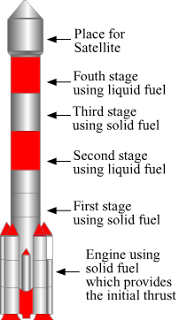Class 10 Chapter 10 Space Mission Solutions
Maharashtra Board Class 10 science chapter 10 space mission Textbook Solutions
Maharashtra state board Biology Textbook Solutions for Class 10 are very important and crusial that helps the students in understanding the hard topics and helps them in the preparation of class 10 board examination as well as verious compititive entrance examinations also. Studying the answers to the questions in the Biology textbook will check your understanding of a particular topic and helps you determine your strengths and weaknesses.
Class 10 science part 1 textbook Solutions for Class 10, science Chapter 10 space mission Maharashtra Board Class 10 science chapter 10 space mission Textbook Solutions.
Maharashtra state board science Textbook Solutions for Class 10 are very important and crusial that helps the students in understanding the hard topics and helps them in the preparation of class 10 board examination as well as verious compititive entrance examinations also. Studying the answers to the questions in the textbook will check your understanding of a particular topic and helps you determine your strengths and weak.
Question 1: Fill in the blanks and explain the statements with reasoning:
a. If the height of the orbit of a satellite from the earth surface is increased, the tangential velocity of the satellite will decrease.
Explanation: This can be easily inferred from the formula of critical or tangential velocity.
b. The initial velocity (during launching) of the Managalyaan, must be greater than escape velocity of the earth.
Question 2: State with reasons whether the following sentences are true or false
a. If a spacecraft has to be sent away from the influence of earth’s gravitational field, its velocity must be less than the escape velocity.
Answer : The statement is false. This is because the minimum velocity with which the spacecraft must be projected so that it escapes the Earth’s gravitational pull is known as escape velocity. So, the initial velocity of the spacecraft must be greater than or equal to escape velocity of Earth.
b. The escape velocity on the moon is less than that on the earth.
Answer : Escape velocity on a planet is given as:
Since, acceleration due to gravity on Moon is one-sixth of that on Earth, thus the escape velocity on the Moon is less than that on the Earth. Hence, the statement is true.
c. A satellite needs a specific velocity to revolve in a specific orbit.
Answer : The specific velocity with which the satellite revolves around a planet is known as critical velocity. It is given as
So, it can be observed that the critical velocity of a satellite changes depending on the height of the orbit from the surface of a planet. Thus, to revolve in a specific orbit, a satellite would require specific velocity. Hence, the statement is true.
d. If the height of the orbit of a satellite increases, its velocity must also increase.
Answer : The specific velocity with which the satellite revolves around a planet is known as critical velocity. It is given as
So, we see that as the height (h) of the orbit of a satellite increases, it velocity must decrease. Hence, the statement is false.
3. Answer the following questions:
a. What is meant by an artificial
satellite? How are the satellites
Classified based on their functions?
Answer -:
Artificial satellite -: Manmade object revolves around the earth or any other planet in a fixed orbit it is called an artificial satellite.
The first artificial satellite ‘Sputnik’ was sent to space by Soviet Union in 1957.
Today, more than thousand satellites are orbiting the earth. S
The satellites work on solar energy. So, solar photovoltaic panels are attached on both sides of these satellites like
wings. Instruments are installed in the satellites to receive and transmit signals from and to the earth.
Classified satellite based on their function -:
1.) Weather satellite -: study and prediction of weather.
2.)Communication satellite -:
Establish communication between different location in the world through use of specific waves.
3.) Broadcast satellite -: Telecasting of television programs.
4.)Navigational satellite-:Fix the location of any place on the earth’s surface in terms of its very precise latitude and longitude.
5.) Military Satellite -:Collect information for security aspects.
6.) Earth Observation Satellite -:Study of forests, deserts, oceans, polar ice on the earth’s surface, exploration and management of natural resources, observation and guidance in case of natural
calamities like flood and earthquake.
b. What is meant by the orbit of a satellite? On what basis and how are the orbits of artificial satellites classified?
Answer -:
Orbit of a satellite :– The orbit is basically defined as a regular, repeating path by which one object in space rotates around another one. The object in an orbit is known as satellite .
Satellite orbits & It’s classification :-
1.)Geo-stationary earth orbit (GEO) -: These satellite have a distance around 36000 km from the earth.
Example – Satellite launched in this orbit to gain all types of Radio signals , Whether signals , TV signals etc.
2) Medium earth orbit (MEO) -: The satellite having distance around 5000-12000 km from the earth surface.
Example – The maximum number of satellite are launching in this area for Transmission.
3). Low earth orbit (LEO) -: The satellite operates from a distance around 500-1500 km.
Example – useful for spying , even can catch small footprint. Delay of the signals is very low.
4).Highly elliptical orbit (HEO)-: The satellite which don’t revolve in a circular orbit are launched in this orbit. Only a very few satellite launched in HEO
c. Why are geostationary satellites not useful for studies of polar regions?
Answer -: The geostationary satellites orbit above the equator. These are, therefore, not useful in the study of polar region.
d.What is meant by satellite launch vehicles? Explain a satellite launch vehicle developed by ISRO with the help of a schematic diagram.
Answer-: Satellite launch vehicles are used, to place the satellites in their specific orbits. The structure of the launch vehicle is decided by the weight of the satellite and the type
of satellite orbit. the weight of the vehicle can be reduced step by step, after its launching. Satellite launch vehicles are used to place the satellites in their specific orbits. The structure of polar satellite launch vehicle (PSLV) developed by ISRO is shown below. It is a vehicle with 4 stages using solid and liquid fuels. The weight of the vehicle decreases after each stage because of consumption of fuel at that stage and detachment of that stage (i.e. the empty tank) from its body. Thus, the vehicle moves with higher speed after every stage.
e. Why it is beneficial to use satellite launch vehicles made of more than one stage?
Answer -:
The fuel forms a major portion of the total weight of the launch vehicle. Thus, the vehicle has to carry a large weight of the fuel with it. To overcome this problem, launch vehicles with more than one stage are used. Due to this, the weight of the vehicle can be reduced step by step, after its launching. For example, consider a launch vehicle having two stages. For launching the vehicle, , the fuel and engine in the first stage are used. This imparts a specific velocity to the vehicle and takes it to a certain height.
Once the fuel in this first stage is exhausted, the empty fuel tank and the engine are detached from the main body of the vehicle and fall either into a sea or on an unpopulated land. As the fuel in the first stage is exhausted, the fuel in the second stage is ignited. However, the vehicle now contains only one (i.e. the second) stage. The weight now being reduced, the vehicle can move with higher speed. Almost all vehicles are made of either two or more stage.
Question 4: Complete the following table.
Answer -:



